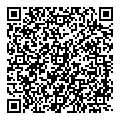|
About QR (Quick Response) Codes
QR (an abbreviation for "Quick Response") codes were
originally designed for use in the automotive industry in Japan by a
subsidiary of Toyota, Denso Wave. The code is patented,
but the patent holder has publically declined to exercise their
patent rights and the specification is published as an ISO
standard ISO/IEC
18004
QR code labels are optical, machine-readable labels that consist
of black and white squares arranged in a square grid on a white
background.
The process of reading a code involves locating three distinctive
squares at the corners of the image, and then using a smaller square
near the fourth corner to normalize the image for size, orientation,
and angle of viewing. The small dots are then converted to binary
numbers and validity checked with an error-correcting code.
The information encoded in the QR code may be made up of almost
any type of data: alphabetic, numeric, binary or Kanji (Japanese
characters). The amount of data that can be contained in a QR
code varies by size. The coarsest code is version 1
(21x21 picture elements) and the largest is version 40
(177x177). In general, the optics on mobile devices are
capable of correctly processing QR code densities up to version 10
(57x57) codes.
The capacity of QR codes is very large: when encoding
conventional latin-1 letters and numbers, a total of 4,276
characters can be put in a version 40 code of about 3 inches
in size. In practical terms, the capacity of a version 10 code
3 inches square is about 400 characters.
As an example, the sample pharmaceutical label below is 1 inch
(2.5 cm) square. It fits on the bottom of a standard
prescription bottle and can be read with the QR code reader on any
mobile device (click here
for a free QR code reader for the iPhone, iPad or iPod.)
 |
This code contains 221 characters of content from real
prescription label. It reads: Joseph P. Customer,
Penicillin V Potassium Oral, 100 mg tablet; take twice per day
until gone. Exp. 2/28/2014. Dr. Jerry Munden.
704-503-1015. Information: http://nlm.nih.gov/medlineplus/druginfo/meds/a685015.html |
This small code, thus, includes the name of the customer,
identifies the medication, dosage and usage information, gives the
name and phone number of the prescribing physician and a link to the
National Library of Medicine page that has the complete information
about the particular formulation of the medication described
(information which is normally provided in tiny type on a very large
piece paper) and all in a small QR code
QR codes are designed to be read correctly or not at all.
They are formatted algorithmically using Reed-Solomon error
correction. QR codes support four levels of error correction to
enable recovery of missing, misread, or obscured data. Greater
redundancy is achieved at the cost of being able to store less
data.
With appropriate error correction, surprisingly large portions of
the code may be obscured and still have the code remain readable --
up to 30% data loss depending on the options used during code
generation. This feature has been exploited by some
advertisers who put their own graphic logos in the middle of the QR
code, obscuring some of the dots that comprise the code.
QR codes that are damaged beyond the limits of the error recovery
algorithm do not give incorrect results; they simply fail to read.
To make your own QR code(s), click here.
|